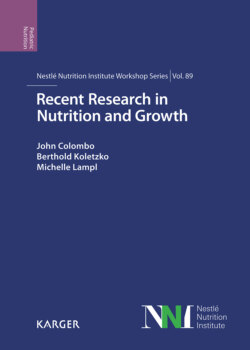Читать книгу Recent Research in Nutrition and Growth - Группа авторов - Страница 29
На сайте Литреса книга снята с продажи.
Mechanisms of Longitudinal Bone Growth
ОглавлениеElongation of the long bones is accomplished by the continuous production and elimination of hyaline cartilage in the growth plate [26]. The two processes are thus controlled to ensure that the height of the structure is not subject to much variation, except during phases of accelerated activity, which occurs for example during the prepubertal growth spurt, when the number of clones of rapidly proliferating cells is augmented [9]. But even then, the increase in the height of the growth plate is not profound, which makes sense also from a biomechanical point of view. The growth plates interrupt not only the structural but also the mechanical continuity of a long bone, in so far as hyaline cartilage is less stiff than osseous tissue. These sites of material property discontinuity are prone to trauma, which is translated into fracturing of the bone at the growth plate site. The risk of such an occurrence would be heightened by a marked increase in the thickness of a growth plate. Slipping of the epiphysis might also occur more frequently and would have a negative impact on longitudinal bone growth.
The axial alignment of growth plate chondrocytes into vertical columns is essential for effective growth. Any disturbance in this anisotropic architecture, which can occur in pathological states such as achondroplasia and chondrodystrophy [11], compromises the activity of the cells without prohibiting either their proliferation or hypertrophy [27].
As was mentioned in the foregoing section (Structure), chondrocytes in the resting zone on the epiphyseal side of the growth plate undergo asymmetric division at a slow rate, with the cycling time in “prepubertal” rats being about 4–5 days [9]. This mitotic activity leads not only to the duplication of resting chondrocytes but also to the generation of new daughter cells that feed the zone of proliferation and have a cycling time of only 2 days in “prepubertal” rats. The number of cells per column that are rapidly proliferating is referred to as the “growth fraction.” The insertion of new cells into a column leads to its elongation and thus to a growth effect. However, since the proliferating cells are relatively flat (ellipsoidal), with an axial height of only 6 µm (Fig. 2a) [5, 9], the longitudinal growth effect that can be achieved in 6-µm increments by the proliferation of a single cell is relatively small when one considers the time that must elapse before the new chondrocyte is ready to undergo mitosis (about 48 h). Hence, not surprisingly, an increase in the growth rate is accomplished by an increase in the “growth fraction,” viz, by an increase in the total number of rapidly proliferating chondrocytes, which is regulated by the mitotic activity of the cells in the resting zone (see Regulation).
The chondrocytes in the proliferative zone run through a limited number of divisions (approximately 4 [3, 25]), upon the completion of which they lose their capacity to duplicate. At this juncture, they begin to undergo hypertrophy. During the hypertrophic phase of their life cycle, the chondrocytes expand rapidly and produce new extracellular matrix to keep pace with the increase in cell volume. The process is complete within 48 h. By means of this mechanism of phenotypic modulation, the axial height of a chondrocyte increases 5- to 6-fold within 2 days in “prepubertal” rats. During the same time frame, the matrix mass per cell is doubled. This process of controlled phenotypic modulation, whereby a directional increase in the height of a cell is achieved by its hypertrophy, is a highly efficient means of effecting the longitudinal growth of a bone, with a 40-µm increase in this parameter being achieved in about 48 h [6, 9]. Within a similar time frame, an increase of only 6 µm would be effected by the proliferation of a cell. In other words, a hypertrophying chondrocyte requires only 7 h to achieve a growth effect that would be realized by a proliferating one only after about 48 h [9].
During hypertrophy, a chondrocyte is programmed to pass sequentially through the phases of rapid “maturation,” “hypertrophy” itself, and “mineralization” induction. Specific cellular and metrical markers for each of these phases have been identified, which include type-X collagen and the S-100 protein [28, 29]. However, in analyses that address the overall activity of the growth plate and the kinetics of its cells, such molecular tags are not of any great informative value.
